MOG was a music blogging site that later incorporated music ad networks and music streaming services. It was once one of the largest music portals for music fans to blog about music, search, listen, share and comment on music and playlists, and discover new songs and bands.
Company: MOG (http://mog.com/)
CEO: David Hyman (former CEO for Gracenote)
Headquarter: Berkeley, CA.
Founded: June 2005
Acquired by: Beats Electronics in 2014
Platforms: Web, iPhone/iPad, Android, Roku, Boxee Box, Sonos, etc.
MOG has secured $33 million through its entire independent business life. Major investors include Universal Music Group (UMG), Menlo Ventures, Balderton Capital, Simon Equity Partners, and Sony Music. It was struggling in the highly competitive music business, with rivals such as Spotify, Rdia, Pandora, Napster, Rhapsody, etc.
It was purchased by HTC Beats in 2012 and permanently shut down on May 31, 2014. Find out what happened to this music startup with its ebbs and flows in the decade-long adventure.
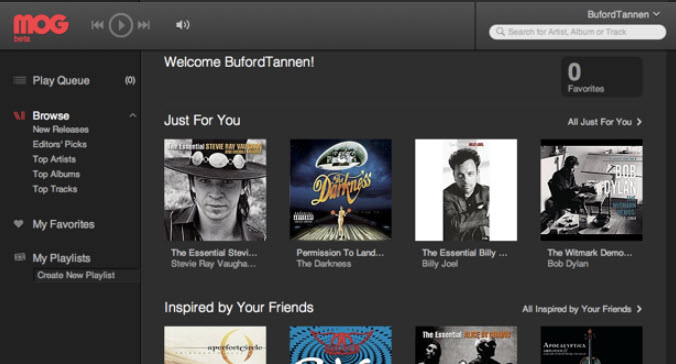
The History of MOG
At the very beginning, MOG was not a dedicated "music streaming service" – the mode we are familiar with Spotify and Apple Music these days. It was born with social networking gene, focusing on music blogging for music aficionados, hence the name MOG.
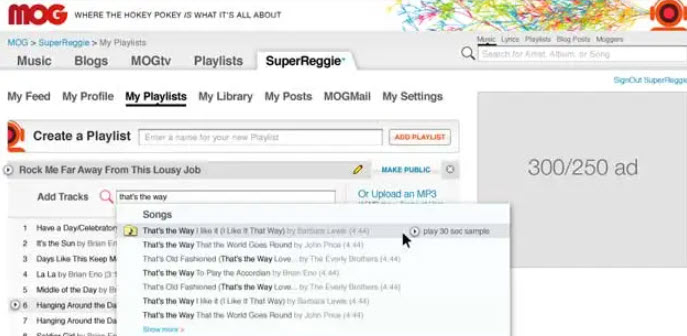
MOG Page and Moggers
This music-themed blogging network allows each user to create their own "MOG" page, showcasing the music they are listening to while allowing other users to view this page, comment on it, and engage in social networking activities.
Just like Last.fm and iLike, MOG uses user data to compare listening habits and suggest new music that users might like. The listening profiles can be shared and commented on, encouraging users to engage with like-minded individuals in a vibrant online community. Users at that time were nicknamed "Moggers", and the networking and music-suggesting features have attracted some music lovers and independent musicians from the very beginning.
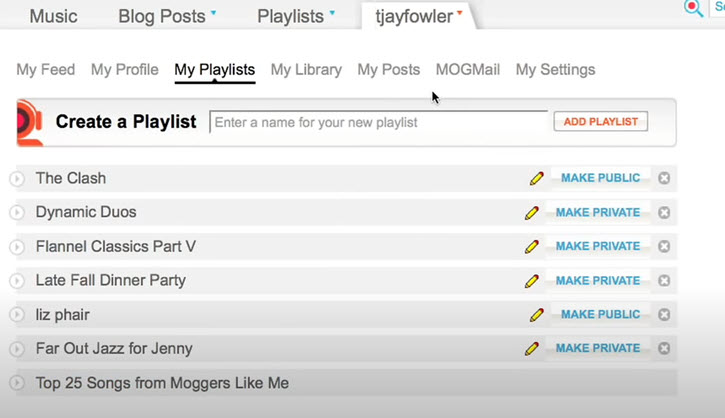
MOG Music Network
In an effort to build up advertising relationships in the music niche, MOG released its ads network: MOG Music Network in August 2008. With it, partner blogs can embed content from other sites, and bloggers can syndicate their own music posts to Mog.com. The revenue share agreement was 50/50 on a CPM basis.
David Hyman, referred to the MOG Music Network as a "Federated Media for music sites". The company included 30 partner sites at launch, catering to small and large sites alike via an application process to ensure quality.
Till then, MOG has received $6 million in funding from angel investors, Universal Music Group, Sony BMG, and The Angels' Forum. The company raised $3.2 million in angel funding, and later announced a $2.8 million strategic investment from two major record labels, Universal Music Group (UMG) and Sony BMG.
According to Venturebeat, the music blogging network has a monthly reach of at least 8 million unique visitors. Alongside the launch of the ads network, Sonja Hoel Perkins of Menlo Ventures joined the board of directors.
MOG All Access: Entry into the Music Subscription Game
In December 2009, MOG announced its music subscription service: MOG All Access, charged at $5 per month with the 1-hour free trial (the model changed to a 3-day limitation two months later). Previously only a music portal with blogs and social networking elements, it now allowed users to access unlimited on-demand streaming of music resources.
Its vast music library consisted of songs from all four major labels (Universal Music Group, Sony Music Entertainment, Warner Music Group, and EMI Music) and many indie labels at that time. The user experience was great, with high definition album art, detailed music metadata, lyrics, and intuitive search and discover features.
MOG Radio: Highlighted Feature of MOG All Access
MOG Radio is one of the most loved features at that time. It allows users to customize their playlists according to their music preferences. The secret is, it allows users to decide how closely related the suggested artists are to their already listened-to artists, by simply dragging the slider.
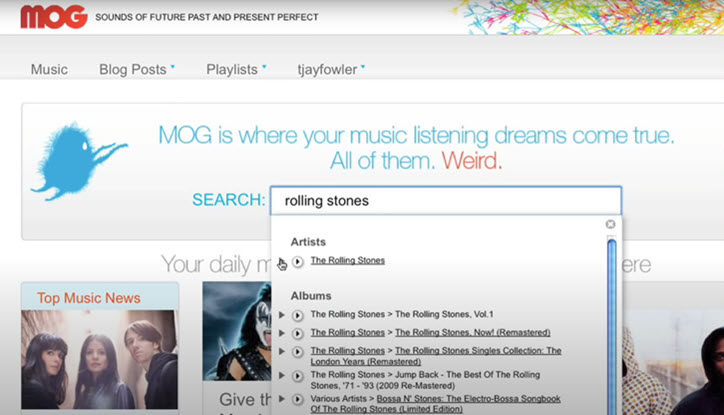
MOG Secured More Investment
MOG raised $9.5 million in a Series E funding round led by Balderton Capital and Menlo Ventures in February 2012. Struggling to gain a foothold in the highly competitive music market, with Napster, Rhapsody, Spotify and other rivals growing steadily and fiercely, the company intended to use the funds to expand into Europe, create mobile apps, and form new partnerships. Dharmash Mistry from Balderton Capital joined MOG's board as part of the funding round.
MOG Forged More Partnerships and Expanded to Multiplatform
In 2010, Techcrunch reported that MOG was quickly catching up with its competitors in the music vertical market. MOG ranked as the 9th biggest music portal and provided numerous music blogs and editorial content, attracting 13.2 million unique monthly visitors in the US.
During 2010-2012, MOG built partnerships with cars, mobile services, TVs, and other related sectors, and released different versions of the app cross-platforms. Below is a brief summary.
2010.3 - MOG launched mobile apps, available for iPhone and Android, which allow unlimited music downloads for $10 a month. The music quality was up to 320 kbps. The downloaded music was saved as caches inside the app, so that people can enjoy music on-the-go without WIFI.
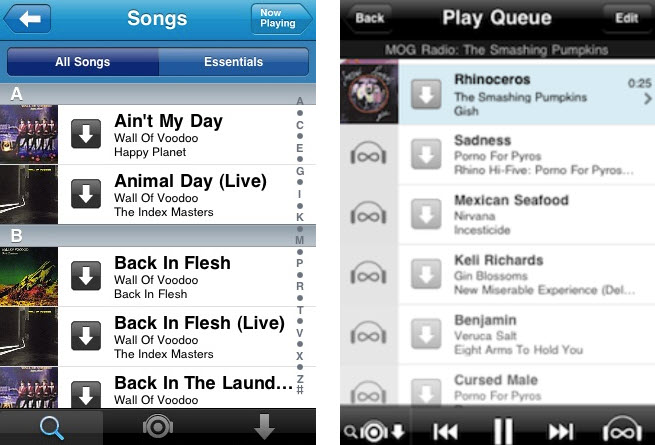
2010.6 - MOG expanded its advertising network by adding Sony Music artist sites.
2010.6 - Roku made the MOG streaming music app available to its users in its app store.
2010.12 - MOG became available on the Chrome Web Store and used HTML5 technology for the UI and playback. It also included a Chrome extension that readily adds music newly discovered by users to the MOG playlist.
2011.1 - MOG secured a deal with Verizon, making it a pre-installed app on all 4G Android phones. Users can subscribe to MOG accounts with Verizon billing.
2011.1 - MOG Fusion was introduced, bringing a premium music service to cars. Manufacturers for home, portable, and car audio devices can integrate with MOG Fusion via licensed APIs.
2011.3 - Mini cooperated with MOG to bring on-demand music service to its cars. Vehicles equipped with the MINI Connected system in the US can playback music with mobile app control.
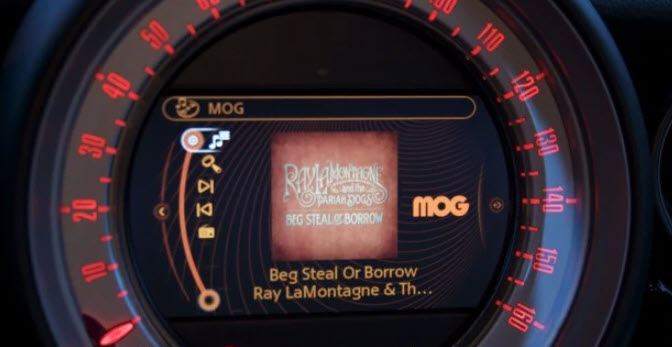
2011.4 - MOG's music subscription service became available on LG Smart TV and Blu-ray players. It offered a 14-day free trial, and was charged at $5/month for TV, or $10/month to include the mobile bundle.
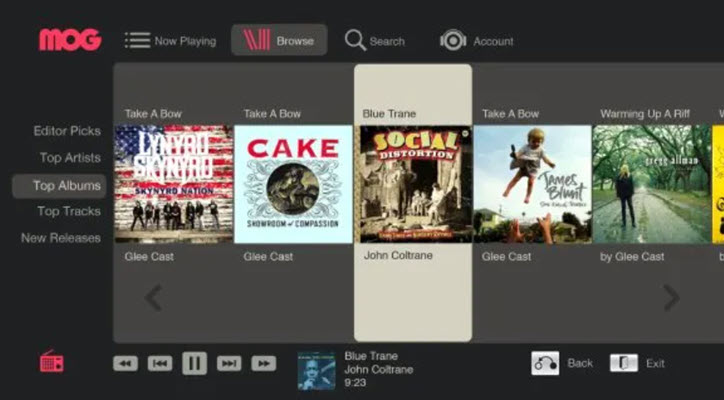
2011.5 – Sonos, a whole-home audio system provider, began streaming MOG music at 320kbps.
2011.6 - MOG introduced a new HTML5 player and collaborated with Facebook. A highlighted feature was its ability to detect users' Facebook likes (and those of their friends) to recommend more artists and music. According to Venturebeat, up to December of that year, MOG saw 246% user growth as a result of its integration with Facebook.
2011.8 - MOG made its music streaming service available on Boxee Box, a set-top device and media extender for TVs. Boxee Box users had access to MOG's vast 11.5-million song catalog, which featured album art in 1080p and 320kbps audio quality.
2011.9 - MOG launched a native desktop app for Mac, and it also supported AirPlay. The interface resembled its HTML5 web player.
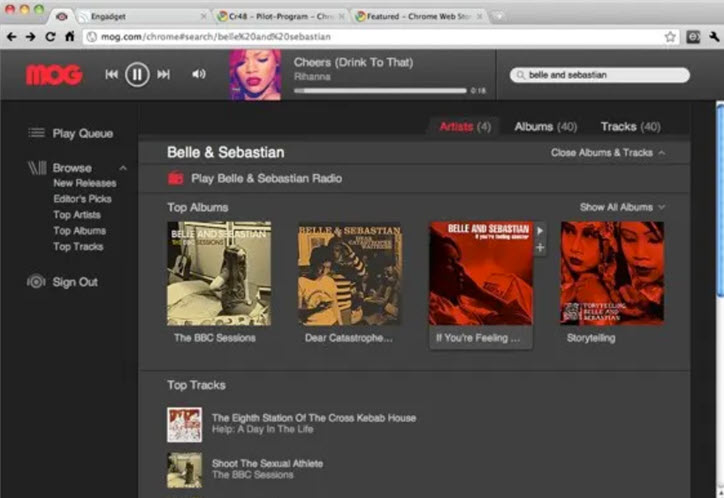
2011.9 - MOG partnered with Samsung to offer its streaming service on smart TVs and Blu-ray players.
2011.11 - Logitech Squeezebox, a streaming audio server, integrated MOG to offer personalized music streaming service. The catalog grew into 13 million at that time.
2012.9 - MOG and Aha Radio collaborated to bring on-demand music streaming to Subaru and Honda vehicles, right available into the app controlled by the in-dash touchscreen.
Rumors About MOG Seeking Buyers
In February 2012, Greg Sandoval from CNET reported that MOG was rumored to sell the service. Numerous sources said that MOG was approaching those in the music industry for the interest of buying out the service, probably in wake of the stiff competition from high-profile rivals like Rhapsody, Rdio, or Spotify. At that time, MOG scored 500,000 paid subscribers, while Spotify boasts three million premium users worldwide.
MOG refused to comment with more details. Instead, representatives from MOG told the public that they are "speaking with companies and looking for the best opportunity for our business and our shareholders. Nothing to confirm at this time".
In March 2012, the rumor went on. CNET, Business Insider, Venturebeat and other publications have reported that MOG might be sold itself to HTC Beats. The latter was rumored to launch a streaming music service. Should the acquisition go through, the Beats-owned MOG service could fit in right away.
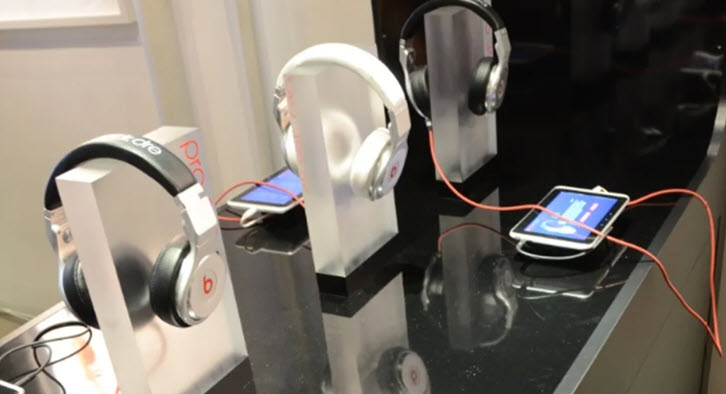
Beats Audio Acquired MOG
In July 2012, after months of rumors and false starts, it was finally confirmed that music streaming service MOG was acquired by headphone maker Beats (majority owned by HTC).
David Hyman, MOG's CEO, said that "the addition of MOG's music service to the Beats portfolio would provide a truly end-to-end music experience". Beats managers were considering a plan to use MOG as the backbone for a Beats-branded online store, where it would offer music, headphones, and other merchandise.
According to the investors' page of HTC, the transaction amount was $14 million. At that time, Spotify, MOG's major rival in music streaming service, was valued at about $4 billion.
In the acquisition, Beats took control of the core audio service from MOG as a separately-managed company, while the ad and music blog components were mostly left untouched.
Luke Wood, president and COO of Beats, comment on the acquisition that "With MOG, we are adding the best music service to the Beats portfolio for the first truly end-to-end music experience. With their talent and technology, the possibilities around future innovation are endless".
What Then Happened to MOG
As noted before, Beats only purchased the core audio service of MOG. One month later, in August 2012, MOG sold its other half - the ads and blog networks - to Townsend Media Group, a major media company in US, with 244 local radio stations as its assets in 51 markets throughout the states. The stakeholders didn't disclose the exact amount of the buyout.
In November 2012, MOG's founder, David Hyman, stepped down as CEO of the music streaming company. Though he would remain as the strategic advisor for Beats-owned MOG. Surprisingly, later in April 2015, Hyman sued Beats for denying him millions of equity, saying that he was "unceremoniously fired in less than a year" and that he was "canned after trying to get rid of another problematic employee".
MOG was shut down by Beats on April 15, 2014, and the date was postponed to May 31, 2014. Beats itself was acquired by Apple Inc. in May 2014.







